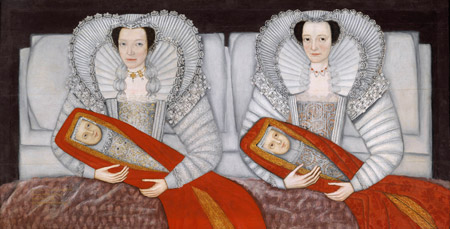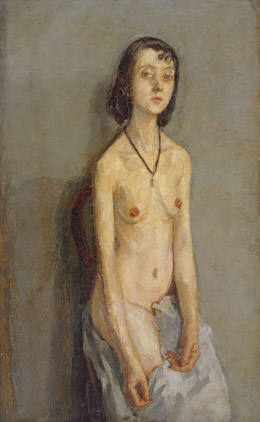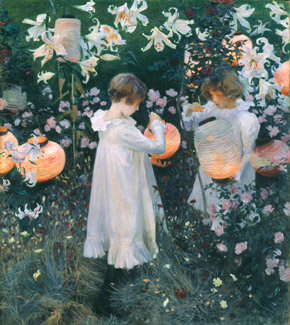“Pictures are not easy to look at,” wrote E.M. Forster in his short essay “On Not Looking at Pictures.” Forster recounted his “long years of wandering down miles of galleries” aided by art historian friends as he grappled with staying focused on the images in front of him, resisting the usual tangents when the “mind takes charge” and, as he terms it, goes off “on some alien vision.” The essay is filled with self-deprecating irony, as Forster struggles to see paintings for what they are, composed and constructed surfaces, formed out of compositional choices, of color and brushstroke. But as much as he tries, he struggles with serious, directed looking. “How much am I missing,” he asks, as he ponders the way art can trigger our meandering thoughts far beyond the object in front of our eyes. In one effort to consider the paintings, Forster imagines them as embodied objects complaining to the lazy viewer: “What have your obsessions got to do with me. I am neither a theater of varieties nor a spring-mattress, but paint. Look at my paint.”
- BP Walk Through British Art
Tate Britain, London
Ongoing
I thought of this painterly complaint as I trudged through the recently reorganized permanent collection at the Tate Britain, feeling the weight of so many portraits constantly calling us to look at their paint. Since its beginnings as the National Gallery of British Art in 1897, the Tate Britain has been dedicated to promoting and displaying works of British art. The collection has been unhinged from earlier thematic or genre focused galleries, and instead presented in what museum director Penelope Curtis calls a “chronological circuit” that creates a “walk through time” covering 500 years of British painting. In each gallery, the dates are marked in brass plating on the floor, signaling a new era, a new set of works, starting from the first gallery of 1540 through to our contemporary moment. But in the echo of the plea, “look at my paint,” there is another call: look how British we are.
But what makes this art British is of course the difficult question, and one that compelled me as I wandered through each of the collection’s 20 galleries. I was struck by the signage in the entrance lobby and used on the museum map that invites us to “Meet British Art.” There is something paradoxical in this phrase—offering an invitation and a directive at the same moment. I was intrigued by the way the phrase, like Forster’s own imagining, conjured the embodiment of art, galleries of personified canvases demanding our attentive interaction. Unlike Forster’s complaining canvas, however, here there is a kind of pleasurable informality that left me wondering how one goes about meeting art? Or, more confusingly, would I know British Art if I shook its hand?

From the first galleries, the question makes itself present. Here you encounter portraits of royalty, distinctive of their age, their subjects proudly embodied in rich details and poised figures. I found “The Chomonderley Ladies”, a 17th century oil on wood painting oddly compelling. It depicts a highly stylized image of two women haloed in white lace, each holding a child wrapped in red. Later I learn that they are sisters who had babies at the same time. At least that is what we think. The artist is unknown, the label only indicating “The British School,” but such a school is not defined or clarified. Context in these new galleries is kept to a minimum. Even the labels for the works are placed well below the frames, their gray color blending with the walls. This is about all about the images.
“The Chomonderley Ladies” sits awkwardly amidst more realist portraits of the era, crowded canvases filled with symbolic objects of social importance. Two portraits by Anthony van Dyck — portraits of Sir William Killigrew and Lady Killigrew — convey this sense of regal repose. Van Dyck, born and trained in Antwerp, became the official painter at the court of Charles I. Painting and painters had a particular place in creating the image of power in the 17th century England.
But such a context holds little consequence in this chronological circuit of painting as time periods and canvases become a kind of flattened experience of images. We wander from van Dyck’s portraits to George Calusen’s “Girl at a Gate” (1889), the subject’s pensive stare catching us as the rustic garden widens behind her, offering a romantic idea of rural life at the very moment when many were moving to congested cities in England. A few decades later we encounter Gwen John’s “Nude Girl” (1909-10), one of only a handful of works by women artists on display. The subject’s presence is direct and assertive, contrasting with the muted tones and softness of the brushstrokes, making this female image both subject and object of our gaze. And still further on, Lucian Freud’s “Girl with White Dog” (1950-1) compels us in its strange composition, and heavy brushwork. Each of these works sits within the genre of portraiture but also reflects the changing meaning of the form. They meet our gaze at different moments in history, and ask us to consider not only the paint on the canvas, but also how portraits themselves hold contrasting meanings over the centuries. This is the strange irony of constructing this collection on a timeline: the historical meanings of art disappear, and leave us with a very contemporary sense of art as a simple set of images. But the cultural importance of such images slips away from us.

Consider the 1840 gallery, a large, airy room displaying paintings from ceiling to eye level, sculptures popping up at different places, at times getting in the way of looking at the paintings. This composition reflects the common 19th century practices of art display, with paintings and sculptures competing for our attention. Look up and find Dante Gabriel Rossetti’s “The Girlhood of Mary Virgin” (1848-9) with its precise details and vibrant colors. Wander down a bit and find John Singer Sargent’s “Carnation, Lily, Lily, Rose” (1885-6) a canvas that radiates with the orange glow of outdoor lanterns on a summer evening, the skillful luminosity carries through to the little girls pinafores and the flutter of lily foliage surrounding them. Turn around and you confront James Whistler’s “Nocturne: Blue and Silver—Chelsea” (1871), a muted vision of the city from the Battersea Bridge looking over the Thames, the paint thick and heavy as it smears across the small canvas, turning the river and landscape into a captivating and hazy abstraction. Each of these works draws on 19th century Aestheticism anchoring an idea of art to the pure beauty of the scene. But in this circuit of images, the paintings float amidst an array of other images, like a kind of online database (as the word “circuit” suggests). In such a display, well-known artists, such as Constable and Turner and Hogarth, mix with the lesser names like Augustus Leopold Egg’s 19th century paintings of social life, or Johan Zoffany’s scenes of colonial India from the late 18th century. This is a gallery experience shaped by digital culture.
Or rather, this is gallery as digital culture. At the end of the last gallery you can sit at one of six computers and explore the collection as a video tour, where you learn social and biographical context about certain works. “Access information about the Tate collection here and on the Tate website” a sign reminds us. The gallery and the online collection merge into one. Which makes the phrase “Meet British Art” quite ironic as it recalls an older era of our experience of art that Forster would have recognized. Each painting offers its own unique encounter between patron and artist, grappling with more than the image but with art as its own subject. Meeting art, I thought, conjures a deeply nostalgic feeling.
But as the paradox of history in this circuit flattens art’s changing meanings over time, so too is there a paradox of nationalism. What makes this work distinctly British is not so clear. Some of the earliest works are done by artists born outside of Britain. Consider the grand landscape of a newly formed St. James’ Park by the 18th century Venetian painter Giovanni Antonio Canal, known as Canaletto. His early paintings of architecturally precise palazzos of Venice became popular souvenirs for British tourists. In London, he continued his distinctive bird’s-eye view of the landscape with scenes in and around the city. But what makes St. James’ Park distinctively British, I wondered. It cannot be considered as part of “the British School.” The work is much more an import or rather an immigrant into the history of British Art. There are other such immigrant artists here, such as the Dutch born van Dyck, the American Whistler, and Zoffany, a German Romantic painter who, as a short text indicates, “Travelled to paint the Empire” in India in the early 19th century.
I thought perhaps it was subject matter that anchored a definition of British art in this collection, until I arrived at Joseph Wright of Derby’s “Vesuvius in Eruption” (1776-80), an imagined view of the volcano’s burst of brilliant molten light. This was a view of Naples, stuck here in the history of British Art. Or consider the more contemporary David Hockney’s “A Bigger Splash” (1967) offering the flat tones and minimalist forms of a Southern California house and pool, the flutter of a splash in the water breaking the painting’s geometry. These are not British subjects, but composed by British born artists. The term “British Art” remains in quotations throughout these galleries as both artists and subjects confuse any firm idea of what makes this art so British. As so often happens, nationalism is something we just have to believe in here, with little evidence of its meaning or importance. Instead, this collection is an imagined community of British art. But like any imagined community, constructed from fragments and ruins, from alien forces assimilated into a whole, it is fragile idea to hold together.
And this is what makes this reorganized collection so intriguing and tiring, as it is filled with paradoxes that confound the very unified premise of the historical circuit it is meant to map. Instead, we are left with a journey through an archive of images that remind us again and again just how difficult it is to look at pictures. And how much we might miss when we meet them.




